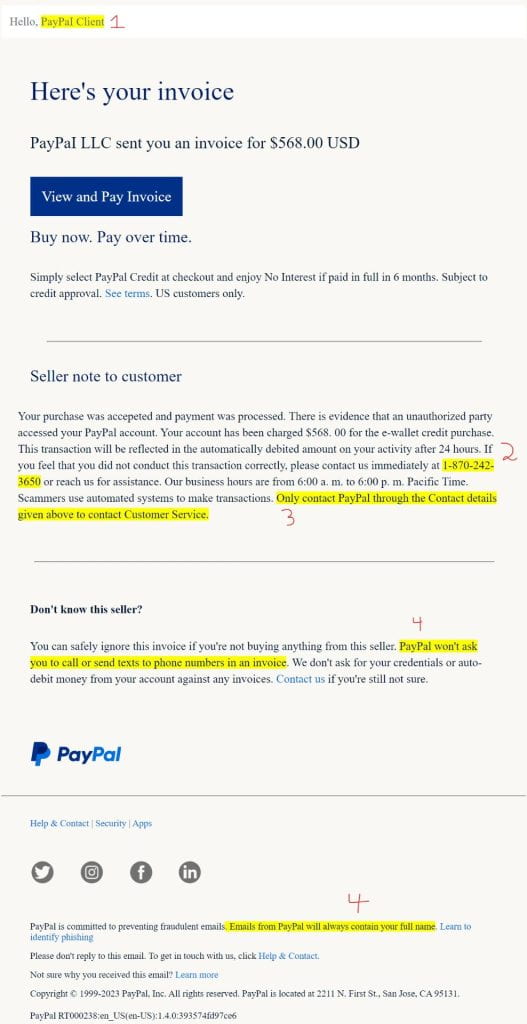The Office of Information Security observes a trend in which criminals send a convincing fraudulent PayPal invoice, hoping that victims will click a malicious link.
If you see a message like the one below, please do not interact with the sender or phone number, and do not follow any special instructions. Simply report the email using the Phish Alert Button (PAB) in your Outlook interface. It is always best to be cautious and report anything remotely suspicious. Our team will analyze all submissions and return them to you if they are determined to be safe. Below, we dissect this phishing attempt to reveal its red flags.

- The email begins with an impersonal greeting. Genuine messages from PayPal will always use the full name listed in your PayPal account.
- The listed customer support phone number is incorrect. (Source)
- The email tells you to contact customer service only using the information they listed. The scammer does not want you to look up PayPal’s true customer service information.
- The email contradicts itself in the fine print. The scammer likely copied PayPal’s design and forgot to remove their security advice.
The message above uses a design similar to PayPal’s, but upon close inspection, you can find cracks in their design. If you ever receive unexpected invoices, do not panic. To confirm your account status or check activity, open the PayPal app or type www.paypal.com into a new browser window and log into your account. Only contact PayPal through the Contact page in their help center or call PayPal Customer Service at 1-888-221-1161.
Avoid this and other phishing scams by following our ten phishing safety tips and related guidance below.
10 Phishing Safety Tips
- Don’t click. Instead of clicking on any link in a suspicious email, type in the URL, or do a search on wustl.edu for the relevant department or page. Even if a website and/or URL in an email looks real, criminals can mask its true destination.
- Be skeptical of urgent requests. Phishing messages often make urgent requests or demands. When you detect a tone of urgency, slow down and verify the authenticity of the sender and the request by using official channels, rather than the information provided by the sender.
- Watch out for grammar, punctuation, and spelling mistakes. Phishing messages are often poorly written. Common hallmarks of phishing are incorrect spelling, improper punctuation, and poor grammar. If you receive an email with these problems, it may be a phishing attempt. Double-check the email address of the sender, don’t follow any links, and verify the authenticity of the request using official channels.
- Keep your information private. Never give out your passwords, credit card information, Social Security number, or other private information through email.
- Pick up the phone. If you have any reason to think that a department or organization really needs to hear from you, call them to verify any request for personal or sensitive information. Emails that say “urgent!”, use pressure tactics or prey on fear are especially suspect. Do an online search for a contact phone number or use the contact number published in the WUSTL directory.
- Use secure websites and pay attention to security prompts. Always check if you are on a secure website before giving out private information. You can determine whether a website is secure by looking for the “https:” rather than just “http:” in the Web address bar or for the small lock icon in the Internet browser. If your browser cannot validate the authenticity of the website’s security certificate, you will be prompted. This is frequently a telltale sign of fraud, and it would be a good time to pick up the phone or report a suspicious message.
- Keep track of your data. Regularly log onto your online accounts and make sure that all your transactions are legitimate.
- Reset any account passwords that may have been compromised.
- Know what’s happening. Visit the Office of Information Security Alerts page often and follow us on Twitter to get the latest WashU Information Security Alerts.
- Report it. If you are a victim of an email scam, report it to our office by using the Phish Alert Button (PAB). When you report a phishing attack, we will investigate it and if necessary, remove other instances of the attack from our systems. Reporting the attack will help protect others and our institution.
Additional Resources
Phishing | Office of Information Security | Washington University in St. Louis
Phishing 101 | Office of Information Security | Washington University in St. Louis